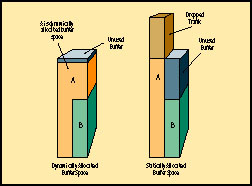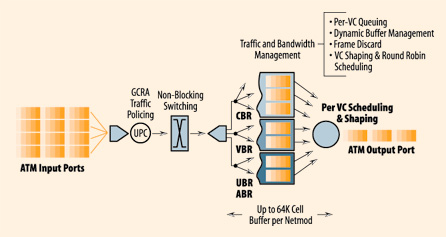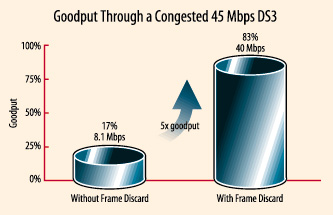
Additionally, the VoicePlusTM network module supports interworking between TDM T-1/E-1 and ATM environments, and the FramePlusTM network module offers standards-based internetworking between ATM and Frame Relay or ATM frame-based UNI (FUNI) services.
The network modules feature industry-standard interfaces ranging from T-1/E-1 to OC-12c/STM-4c supporting fiber, coax and copper media. This variety of interfaces gives the ASX and TNX switch families the flexibility to support a wide range of enterprise and service provider LAN and WAN applications.
Sophisticated per-VC bandwidth and congestion management techniques ensure that contracted service levels are satisfied for each connection. Per-VC buffer management effectively isolates users from one another protecting each user's service level from being impacted by other connections.
The network modules adhere to the latest standards for traffic management, physical connectivity, facility maintenance, diagnostic loopbacks, etc., ensuring interoperability with standards-based ATM services and equipment.
The family of ATM switch network modules are interchangeable across the TNX and ForeRunner ASX product lines, maximizing investment protection as network modules are moved from one class of switch to another to accommodate network expansion and new service level requirements.
System capacity is easily grown by simply adding a network module to one of the modular ATM switches. The modules are hot swappable, supporting in-service expansion and replacement, reducing maintenance downtime.

Figure 1: Comparison of Dynamic vs. Static Buffers:
This diagram represents a two-port Network Module with
ports labeled as 'A' and 'B.'
(The figure on the right shows statically-allocated
buffers.)
Static buffers do not have the flexibility to reassign
buffer space on an as-needed basis. Therefore, they drop several cells
from port 'A' even though buffer space is unused and rigidly assigned to
port 'B.'
(The figure on the left shows dynamically-allocated
buffers.)
The dynamically-allocated buffers can support both
'A' and 'B' traffic because they have the flexibility to assign buffers
to each port on an "as-needed" basis.
In particular, unshaped connections are susceptible to this policing action in which traffic behavior such as cell clumping (e.g., which can result from the statistical multiplexing of many connections) can result in a violation of certain QoS parameters.

Figure 2: Per-VC Shaping and Scheduling Illustration
Two integrated Frame Discard techniques, Partial Packet Discard (PPD) and Early Packet Discard (EPD, work together to maximize goodput by localizing the impact of port congestion to as few packets as possible.
 .
.
Figure 3. Frame Discard Comparison:
This illustration is based on actual testing that shows how these techniques improve goodput on congested ports by as much as 75%.
Explicit Rate ABR goes beyond earlier ABR flow control mechanisms by not only indicating that there is congestion, but also specifying the rates at which the traffic source must operate to avoid network congestion. This allows ATM traffic sources to generate the optimal amount of traffic, virtually eliminating congestion on the most heavily utilized ATM links, such as inter-switch links and connections to network servers.